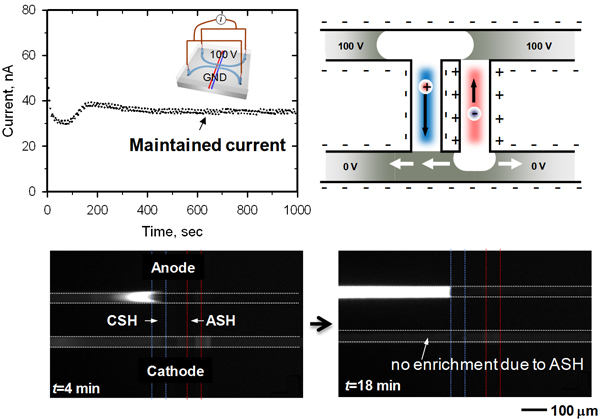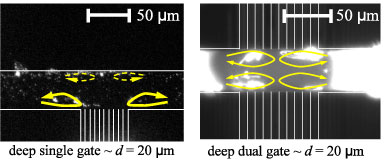Nonlinear electrokinetics - Micro/Nanofluidic BioMEMS Group
Executive Summary
Ion concentration polarization (ICP) is the fundamental transport phenomenon that occurs near ion-selective membranes, but this important membrane phenomenon has been poorly understood due to theoretical and experimental challenges. It is because chemical diffusion, drift, and (nonlinear electrokinetic) fluid flow in the ICP system are tightly coupled with each other. Therefore, Poisson’s equation, Nernst-Planck equation and Navier-Stockes equation should be solved concurrently. In addition, ICP typically involves widely different scales of length, concentration, and fields.
Our group focuses on developing ICP system on microfludic chip and analyzing ICP phenomenon both theoretical and experimental approaches; a) find factors which govern the ICP system, b) direct measurements of detailed flow, electric potential profiles in the system. Also we search the applications by using this nonlinear electrokinetic flow phenomenon.
• Kim, P., Kim S. J., Suh, K.-Y., and Han. J., “Stabilization of Ion Concentration Polarization Using a Heterogeneous Nanoporous Junction,” Nano Letters, 2010, 10, 16-23.
We demonstrate a recycled ion-flux through heterogeneous nanoporous junctions, which induce stable ion concentration polarization with an electric field. The nanoporous junctions are based on integration of ionic hydrogels whose surfaces are negatively or positively charged for cationic or anionic selectivity, respectively. Such heterogeneous junctions can be matched up in a way to achieve continuous ion-flux operation for stable concentration gradient or ionic conductance. Furthermore, the combined junctions can be used to accumulate ions on a specific region of the device.

• Kim, S.J., Li, L.D., and Han, J., “Amplified Electrokinetic Response by Concentration Polarization near Nanofluidic Channel,” Langmuir, 25, 7759-7765 (2009).
We aim to be the first direct measurements of detailed flow and electric potential profiles within and near the depletion region. Using microfabricated electrodes integrated with the microfluidic device, we measured and confirmed that the electric field inside an ion depletion region is amplified more than 30-fold compared to outside of the depletion zone due to the highly nonuniform ion concentration distribution along the microchannel. As a result, the electrokinetic motion of both fluid (electroosmosis) and particle (electrophoresis) was significantly amplified by utilizing particle tracking method and photobleaching method. We further showed that the amplified electrokinetic flows generated in this device may be used as a field-controlled, microfluidic fluid pump and switch.

Kim, S. J., Wang, Y.-C., Lee, J. H., Jang, H. and Han, J. “Concentration polarization and nonlinear electrokinetic flow near a nanofluidic channel,” Physical Review Letters, 99, 044501.1-4 (2007).
We aim to be the first experimental, microscopic study on nonlinear electrokinetic flow generated by nanochannels, which can be useful in understanding perm-selective membrane systems. A perm-selective nanochannel could initiate concentration polarization near the nanochannel, significantly decreasing (increasing) the ion concentration in the anodic (cathodic) end of the nanochannel. In addition, fast fluid vortices were generated at the anodic side of the nanochannel due to the nonequilibrium electro-osmotic flow (EOF), which was at least ~ 10x faster than predicted from any equilibrium EOF. Such strong vortices induce fast mixing and destroy any concentration gradient inside the depletion region. This observation confirmed the previous hypothesis that such a strong convection is one of the mechanisms to explain overlimiting currents in the perm-selective membrane.


